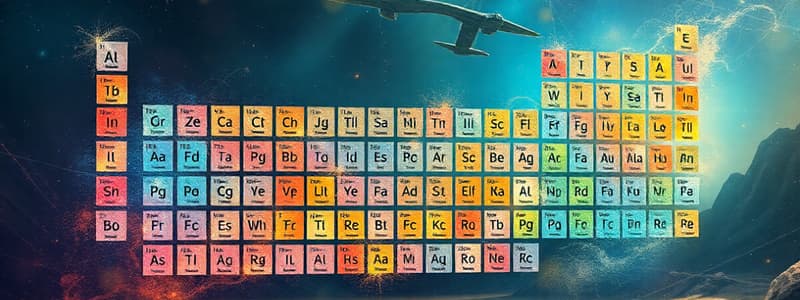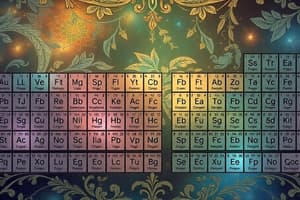Podcast
Questions and Answers
What distinguishes the elements in group 1 of the periodic table?
What distinguishes the elements in group 1 of the periodic table?
- They have 2 valence electrons.
- They are found in nature only as solids.
- They are all gases at room temperature.
- They are extremely reactive and have 1 valence electron. (correct)
Which of the following statements about noble gases is true?
Which of the following statements about noble gases is true?
- They are the most stable group in the periodic table. (correct)
- They are all solids at room temperature.
- They have 7 valence electrons.
- They gain or lose electrons easily.
What are the primary components categorized as non-metals in the periodic table?
What are the primary components categorized as non-metals in the periodic table?
- Transition metals and alkali metals.
- Halogens and noble gases. (correct)
- Alkaline earth metals and metalloids.
- Lanthanides and actinides.
Which group on the periodic table is known for having elements that are very reactive and primarily found in nature as compounds?
Which group on the periodic table is known for having elements that are very reactive and primarily found in nature as compounds?
How are the transition metals characterized in comparison to groups 1 and 2?
How are the transition metals characterized in comparison to groups 1 and 2?
What is the significance of the period number on the periodic table?
What is the significance of the period number on the periodic table?
Which of the following statements is true regarding actinides?
Which of the following statements is true regarding actinides?
Which of the following statements about metals is NOT true?
Which of the following statements about metals is NOT true?
Flashcards
Periods
Periods
The horizontal rows on the periodic table. The period number indicates the number of energy levels within that period. It also tells us how many electron shells will be in a Bohr diagram. For example, Period 1 has 1 shell, Period 2 has 2 shells, and so on.
Groups/Families
Groups/Families
The vertical columns on the periodic table. Elements in the same group share similar physical and chemical properties, including reactivity.
Metals
Metals
Elements on the left side of the periodic table. They are good conductors of electricity and heat, and are solid at room temperature except for mercury. Divided into Alkali Metals, Alkaline Earth Metals, Transition Metals, and Lanthanides & Actinides.
Alkali Metals
Alkali Metals
Signup and view all the flashcards
Alkaline Earth Metals
Alkaline Earth Metals
Signup and view all the flashcards
Non Metals
Non Metals
Signup and view all the flashcards
Halogens
Halogens
Signup and view all the flashcards
Noble Gases
Noble Gases
Signup and view all the flashcards
Study Notes
The Periodic Table
- Invented in the 1800s by Mendeleev, a table of chemical elements
- Elements 1-92 are naturally occurring, 93-102 are man-made
- Elements are arranged based on atomic number and properties
- Periods: Horizontal rows; number represents energy levels/electron shells
- Groups/Families: Vertical columns; similar physical and chemical properties
- Three main categories: Metals, Nonmetals, Metalloids
Metals
- Located on the left side of the table
- Good conductors of heat and electricity
- Typically solid at room temperature (except Mercury)
- Divided into subgroups:
- Alkali Metals (Group 1): 1 valence electron, highly reactive, form 1+ ions
- Alkaline Earth Metals (Group 2): 2 valence electrons, reactive, form 2+ ions
- Transition Metals (Groups 3-12): Variable properties, less reactive
- Lanthanides and Actinides: Rare earth elements, found at the bottom of the table
Nonmetals
- Located on the right side of the table
- Poor conductors of heat and electricity
- Exist as solids, liquids (Bromine), or gases
- Divided into subgroups:
- Halogens (Group 17): 7 valence electrons, highly reactive, form 1- ions
- Noble Gases (Group 18): 8 valence electrons (full outer shell), unreactive
Metalloids
- Located along a stair-step line
- Exhibit both metal and nonmetal properties
- Slightly lustrous, brittle
Identifying Atoms on the Periodic Table
- Atomic Number: Number of protons (equal to electrons in a neutral atom); unique for each element
- Element Symbol: One or two letter abbreviation for an element (first letter capitalized)
- Element Name
- Atomic Mass: Average mass of an atom; unit (u); number of protons + neutrons
Octet Rule
- Atoms tend to gain, lose, or share electrons to achieve a full outer electron shell (8 electrons, excluding Hydrogen and Helium)
- This stability makes them unreactive.
Studying That Suits You
Use AI to generate personalized quizzes and flashcards to suit your learning preferences.




